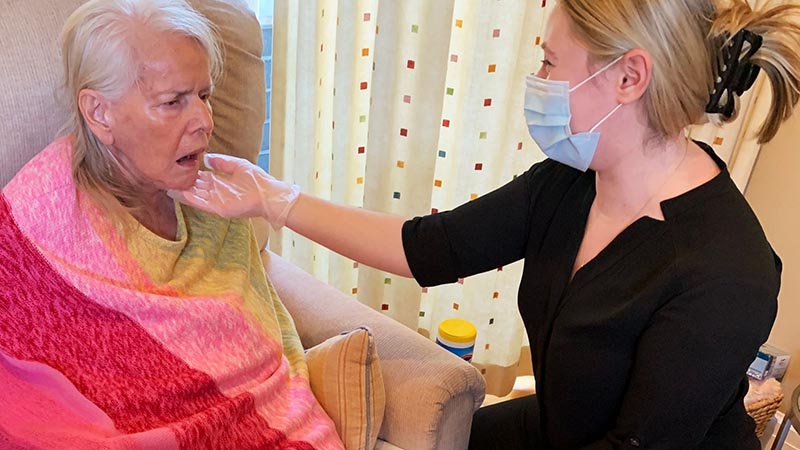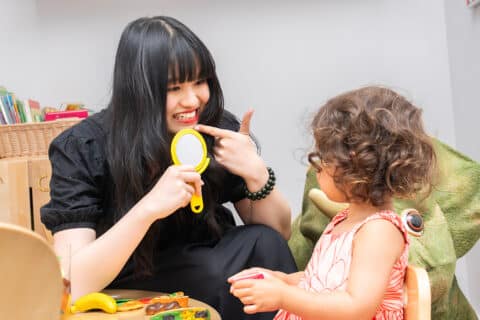What Happens in Adult Speech Therapy?

From the time you wake up in the morning to the time you go to sleep at night, you spend the majority of your day communicating. Whether it is through speaking, writing, reading, or listening, you are constantly engaged in activities that are linguistically and cognitively demanding.
For many, understanding what people say or using language to express yourself seems like second nature. However, millions of Americans suffer from speech and language disorders that make these tasks challenging.
To help rebuild skills or regain confidence with communication, adults may seek speech therapy after a stroke, when diagnosed with a neurodegenerative disease such as Parkinson’s disease or dementia, as well as to improve articulation and fluency. In addition, adults may seek elective services such as accent neutralization or support with public speaking. We are here to help you understand what happens in adult speech therapy.
Common Speech Disorders Requiring Speech Therapy
Approximately 40 million Americans have communication disorders. These disorders affect how you deliver words, sounds, and how you communicate with others.
Producing speech includes the coordination of many things, including:
- Thinking, remembering, and organizing your thoughts
- Listening and understanding what you hear
- Retrieving words
- Arranging words in the proper syntactic order
- Coordinating respiration and phonation to speak with adequate volume and vocal quality
- Using prosody and tone to convey an emotion
- Coordinating the speech mechanism to articulate desired sounds
Below, you will find three of the most common disorders that your speech-language pathologists (SLP) can help with.
Aphasia
Aphasia is an acquired, neurological language disorder that can affect the way you understand and express verbal or written language.
Adults can develop aphasia following brain damage, such as traumatic brain injury (TBI), cerebrovascular accident (CVA), brain tumors, or other neurological diseases.
There are several types of aphasia, all ranging in severity. Each person’s experience is unique and even a mild issue can significantly impact the quality of life. Global aphasia, Broca’s aphasia (non-fluent), and Wernicke’s aphasia (fluent) are most common. Depending on your diagnosis, you may experience fragmented speech, problems with word retrieval, or difficulty understanding what you hear if people speak too quickly or within-group conversation.
Apraxia
Acquired apraxia of speech is another type of neurologically-based speech disorder that can occur following a neurological injury, such as CVA, or from a progressive condition, such as dementia. Apraxia is a motor speech disorder, meaning that the brain has difficulty planning and sequencing the motor movements necessary to speak. The relationship between knowing what you want to say and making your tongue, lips, and jaw make the requisite movements is interrupted.
You may show signs of verbal apraxia if you have slow, effortful speech, inconsistent errors when trying to speak, difficulty initiating words, issues with adding or omitting sounds, or groping (i.e., trying to move your lips, jaw, and tongue to make a particular sound but not quite being able to do so accurately).
Dysarthria
Dysarthria is a motor speech disorder that occurs when the muscles required for speech are weak or uncoordinated due to brain damage. Dysarthria can affect your respiration, phonation, and articulation, making it challenging to speak with adequate loudness and clarity.
This neurologically-based speech disorder may result from illnesses such as CVA, Parkinson’s disease, atypical parkinsonism, amyotrophic lateral sclerosis (ALS), Huntington’s disease, or multiple sclerosis (MS). If you have dysarthria, your speech may sound slurred, mumbled, or too fast or slow. People with dysarthria may find it difficult to participate in social situations such as speaking on the phone or meeting up with friends due to reduced intelligibility.
Speech Therapy Techniques
The techniques, methods, and intensity of your therapy depend on many factors. You will undergo a series of tests for your clinician to gather baseline data and to understand your needs and goals. Your speech-language pathologist will consider your medical history, strengths and weaknesses noted during the evaluation process, responsiveness to trialed therapy techniques, and other factors that will impact your prognosis for recovery or improvement. Then, they will come up with a plan to help you rebuild your life, improve your communication, or enhance your delivery.
While each of these areas requires different treatment techniques and treatment intensities, all programs use core principles of neuroplasticity and motor learning. Improving a current skill or rebuilding an old skill is like anything in life: practice, repetition, and salience.
You will receive tailored exercises in a specific mode of treatment (e.g., intensive) to help you meet your individualized goals efficiently. Not only will you practice these in a professional setting, you will also incorporate them as part of a daily home exercise routine so the gains you make in therapy can be generalized to all aspects of your day-to-day life. The end goal is to transfer the skills learned in an intensive program or speech therapy to your career, personal life, and favorite hobbies.
Speech Therapy Exercises for Adults
Speech therapy does not end when you leave an appointment. For best results, follow any exercise recommendations provided by your speech-language pathologist. Stay positive and be willing to participate, even if you are feeling frustrated. Remember, your SLPs are there to offer their expertise and support you in achieving your goals.
Speech therapy techniques and exercises will vary for each individual. Here are examples of how exercises are incorporated within a program to help treat these various conditions:
Rehabilitation After a Stroke
Your SLP may use a combination of drill-based exercises and functional activities to improve your ability to understand, speak, read, and write after a stroke. This can include cognitive exercises such as visualization techniques to increase attention and memory; sentence generation tasks to improve your vocabulary and word retrieval, or vocal exercises to improve the clarity of your speech.
You may also take part in functional activities such as role-play conversations or the preparation of functional tasks that can help you regain your confidence with your professional and personal responsibilities.
Schedules will vary with each individual, but you can expect to spend five to 10 hours per week online and five to 15 hours per week in-person. The schedule includes exercises, activities, relaxation, rest, and other recommendations important for your individualized program.
Improving Voice, Fluency, and Articulation
The focus here is to target exercises that allow you to speak more clearly and be better understood. Voice problems can result from a variety of medical causes, including vocal cord lesions or muscle tension. After consulting with you and your otolaryngologist/ENT about your specific symptoms and medical history, you will then receive a comprehensive assessment that examines your breathing, voicing, and speech habits that may contribute to your decreased intelligibility.
The focus in articulation treatment for adults is to target exercises to allow you to speak more clearly and be better understood. During an initial assessment, your SLP will determine which specific sounds would benefit from improvement and target production of these sounds within a hierarchy, first in isolation, followed by words, sentences, reading, and conversation. Conversational skills progress from casual dialogue, such as greeting someone and making “small talk,” to more complex conversations such as work-related topics.
You can also take part in exercises to target stuttering, or fluency disorders. These resonant-based exercises help you find a “forward voice” that helps you maintain a strong voice while decreasing laryngeal tension. The focus is on moving resonance forward in the oral cavity and finding the healthiest way to phonate. You can also benefit from more traditional fluency techniques such as “easy onset,” where you practice bringing your vocal folds together gently when saying words beginning with a vowel to reduce hard glottal attacks. These exercises progress from a foundational sound, to syllables, then words, sentences, and conversations.
Enhancing Public-Speaking Abilities
It is common for people or employees in forward-facing roles to want to enhance their delivery. Certain techniques will improve the efficiency of your message and will teach you how to confidently engage an audience. You will be able to speak publicly with less anxiety or hesitation, become a better communicator during meetings, when communicating with clients, and when leading presentations.
Examples of exercises include reading techniques where you shift pacing, intonation, and stress. These exercises change your overall delivery so you can learn how to emphasize various parts of your message. You may also take part in role-playing tasks where you can prepare for an upcoming meeting at work or a public speaking engagement.
Accent Reduction
To neutralize an accent, your SLP will help you target your perception of speech, accurate production of speech sounds that contribute to the accent, and improvement in intonation and coordination of speaking. You will progress from working on individual sounds in isolation to producing sounds at the word level, as well as in sentences, paragraphs, and conversations. Once you reach paragraph and conversational levels, they will help you shift your manner of speaking and improve intonation that will help reduce your accent.
Vocal Coaching for Professionals
Attorneys, executives, public speakers, voice-over artists, teachers, actors, actresses, and anyone who uses their voice in a professional setting can experience communication challenges. Your SLP will determine if those difficulties are due to overuse, misuse, or abuse of your voice (requiring therapeutic intervention), or from lack of voice and speech training (requiring education and communication training).
How Long Does Speech Therapy Last for Adults?
As adults, we have deeply ingrained habits that impact how we speak and communicate. Working on these habits may take some time to master and feel natural. Motivation and intensity of practice are factors that most significantly affect how quickly you see results in your individual program. Other factors include your specific goals (e.g., returning to life in retirement or regaining skills for the workplace as an attorney), the extent of your neurological injury, and your feelings or beliefs about your communication difficulties
For example, participating in an intensive program post-stroke or for cognitive-communication disorders with speech sessions four to five times a week for one or more hours each day combined with a home exercise program will generally lead to significant improvement in one month. You can then renew the program on a monthly basis until you meet and exceed your goals.
If you are participating in speech therapy to improve the clarity of your speech, fluency, voice, or public speaking skills, you can expect to see results within one to three months. Individual goals may vary, and you can continue speech exercise sessions to meet your specific needs.
Adult Speech Therapy at Open Lines®
Whether you are recovering from an illness or trauma, need to overcome speech or voice difficulties, or want to professionally communicate with excellence, we help you navigate your personal journey to achieve a successful, meaningful outcome.
Open Lines®’ proprietary PRESENCE Approach© combines cutting-edge research from diverse medical fields and applies it to the latest clinical best practices. We implement a blend of scientific expertise with the art of intuitive caring to help you achieve success by focusing on your emotional, psychological, and counseling needs. We apply a variety of principles to impact your ability to enhance your internal motivation, drive, feelings of well-being, and ability to regulate your emotions so you can succeed.
Successful treatment requires you to be able to initiate, participate, and maintain compliance with our exercise recommendations — even through periods where you may struggle. For that reason, we work unusually close with you, one-on-one, encouraging you to “show up” and commit to achieving your goals. We will be with you every step of the way!
A Holistic Approach to Speech Therapy
Open Lines®’ approach to speech-language pathology is holistic, meaning we treat you as a unique, whole being with multidimensional needs. At the highest levels, we recognize you have both cognitive-communication and physical needs, such as thinking and understanding language versus voicing and swallowing.
There are also psychological and emotional considerations — the internal states or feelings that can make or break your progress and success. Our experts help you successfully manage all these factors, be it redefining yourself, recovering and returning to work, or attaining a better quality of life.
If you’re struggling with communication difficulties, it’s time to turn to Open Lines®. Contact us via phone (212-430-6800), email [email protected], or by filling out our convenient contact form. Improve your communication skills and unlock your potential with Open Lines® Speech and Communication in New York today!
Get in Touch With Open Lines®














